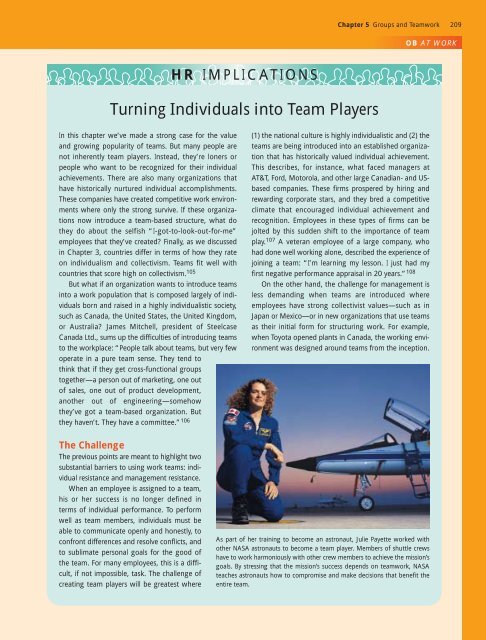Groups and Teamwork - Pearson Canada
Groups and Teamwork - Pearson Canada
Groups and Teamwork - Pearson Canada
You also want an ePaper? Increase the reach of your titles
YUMPU automatically turns print PDFs into web optimized ePapers that Google loves.
Chapter 5 <strong>Groups</strong> <strong>and</strong> <strong>Teamwork</strong> 209<br />
OB AT WORK<br />
HR IMPLICATIONS<br />
Turning Individuals into Team Players<br />
In this chapter we’ve made a strong case for the value<br />
<strong>and</strong> growing popularity of teams. But many people are<br />
not inherently team players. Instead, they’re loners or<br />
people who want to be recognized for their individual<br />
achievements. There are also many organizations that<br />
have historically nurtured individual accomplishments.<br />
These companies have created competitive work environments<br />
where only the strong survive. If these organizations<br />
now introduce a team-based structure, what do<br />
they do about the selfish “I-got-to-look-out-for-me”<br />
employees that they’ve created? Finally, as we discussed<br />
in Chapter 3, countries differ in terms of how they rate<br />
on individualism <strong>and</strong> collectivism. Teams fit well with<br />
countries that score high on collectivism. 105<br />
But what if an organization wants to introduce teams<br />
into a work population that is composed largely of individuals<br />
born <strong>and</strong> raised in a highly individualistic society,<br />
such as <strong>Canada</strong>, the United States, the United Kingdom,<br />
or Australia? James Mitchell, president of Steelcase<br />
<strong>Canada</strong> Ltd., sums up the difficulties of introducing teams<br />
to the workplace: “People talk about teams, but very few<br />
operate in a pure team sense. They tend to<br />
think that if they get cross-functional groups<br />
together—a person out of marketing, one out<br />
of sales, one out of product development,<br />
another out of engineering—somehow<br />
they’ve got a team-based organization. But<br />
they haven’t. They have a committee.” 106<br />
(1) the national culture is highly individualistic <strong>and</strong> (2) the<br />
teams are being introduced into an established organization<br />
that has historically valued individual achievement.<br />
This describes, for instance, what faced managers at<br />
AT&T, Ford, Motorola, <strong>and</strong> other large Canadian- <strong>and</strong> USbased<br />
companies. These firms prospered by hiring <strong>and</strong><br />
rewarding corporate stars, <strong>and</strong> they bred a competitive<br />
climate that encouraged individual achievement <strong>and</strong><br />
recognition. Employees in these types of firms can be<br />
jolted by this sudden shift to the importance of team<br />
play. 107 A veteran employee of a large company, who<br />
had done well working alone, described the experience of<br />
joining a team: “I’m learning my lesson. I just had my<br />
first negative performance appraisal in 20 years.” 108<br />
On the other h<strong>and</strong>, the challenge for management is<br />
less dem<strong>and</strong>ing when teams are introduced where<br />
employees have strong collectivist values—such as in<br />
Japan or Mexico—or in new organizations that use teams<br />
as their initial form for structuring work. For example,<br />
when Toyota opened plants in <strong>Canada</strong>, the working environment<br />
was designed around teams from the inception.<br />
The Challenge<br />
The previous points are meant to highlight two<br />
substantial barriers to using work teams: individual<br />
resistance <strong>and</strong> management resistance.<br />
When an employee is assigned to a team,<br />
his or her success is no longer defined in<br />
terms of individual performance. To perform<br />
well as team members, individuals must be<br />
able to communicate openly <strong>and</strong> honestly, to<br />
confront differences <strong>and</strong> resolve conflicts, <strong>and</strong><br />
to sublimate personal goals for the good of<br />
the team. For many employees, this is a difficult,<br />
if not impossible, task. The challenge of<br />
creating team players will be greatest where<br />
As part of her training to become an astronaut, Julie Payette worked with<br />
other NASA astronauts to become a team player. Members of shuttle crews<br />
have to work harmoniously with other crew members to achieve the mission’s<br />
goals. By stressing that the mission’s success depends on teamwork, NASA<br />
teaches astronauts how to compromise <strong>and</strong> make decisions that benefit the<br />
entire team.

















